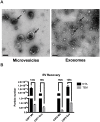Comparative Analysis of Technologies for Quantifying Extracellular Vesicles (EVs) in Clinical Cerebrospinal Fluids (CSF)
- PMID: 26901428
- PMCID: PMC4763994
- DOI: 10.1371/journal.pone.0149866
Comparative Analysis of Technologies for Quantifying Extracellular Vesicles (EVs) in Clinical Cerebrospinal Fluids (CSF)
Abstract
Extracellular vesicles (EVs) have emerged as a promising biomarker platform for glioblastoma patients. However, the optimal method for quantitative assessment of EVs in clinical bio-fluid remains a point of contention. Multiple high-resolution platforms for quantitative EV analysis have emerged, including methods grounded in diffraction measurement of Brownian motion (NTA), tunable resistive pulse sensing (TRPS), vesicle flow cytometry (VFC), and transmission electron microscopy (TEM). Here we compared quantitative EV assessment using cerebrospinal fluids derived from glioblastoma patients using these methods. For EVs <150 nm in diameter, NTA detected more EVs than TRPS in three of the four samples tested. VFC particle counts are consistently 2-3 fold lower than NTA and TRPS, suggesting contribution of protein aggregates or other non-lipid particles to particle count by these platforms. While TEM yield meaningful data in terms of the morphology, its particle count are consistently two orders of magnitude lower relative to counts generated by NTA and TRPS. For larger particles (>150 nm in diameter), NTA consistently detected lower number of EVs relative to TRPS. These results unveil the strength and pitfalls of each quantitative method alone for assessing EVs derived from clinical cerebrospinal fluids and suggest that thoughtful synthesis of multi-platform quantitation will be required to guide meaningful clinical investigations.
Conflict of interest statement
Figures




Similar articles
-
Characterization of extracellular vesicles and synthetic nanoparticles with four orthogonal single-particle analysis platforms.J Extracell Vesicles. 2021 Apr;10(6):e12079. doi: 10.1002/jev2.12079. Epub 2021 Apr 6. J Extracell Vesicles. 2021. PMID: 33850608 Free PMC article.
-
Possibilities and limitations of current technologies for quantification of biological extracellular vesicles and synthetic mimics.J Control Release. 2015 Feb 28;200:87-96. doi: 10.1016/j.jconrel.2014.12.041. Epub 2014 Dec 30. J Control Release. 2015. PMID: 25555362 Free PMC article.
-
Large Extracellular Vesicles Can be Characterised by Multiplex Labelling Using Imaging Flow Cytometry.Int J Mol Sci. 2020 Nov 18;21(22):8723. doi: 10.3390/ijms21228723. Int J Mol Sci. 2020. PMID: 33218198 Free PMC article.
-
Methods to Analyze EVs.Methods Mol Biol. 2017;1545:1-20. doi: 10.1007/978-1-4939-6728-5_1. Methods Mol Biol. 2017. PMID: 27943203 Review.
-
Unlocking the secrets of single extracellular vesicles by cutting-edge technologies.Pathol Res Pract. 2025 May;269:155878. doi: 10.1016/j.prp.2025.155878. Epub 2025 Feb 28. Pathol Res Pract. 2025. PMID: 40024075 Review.
Cited by
-
Size Sorting of Exosomes by Tuning the Thicknesses of the Electric Double Layers on a Micro-Nanofluidic Device.Micromachines (Basel). 2020 Apr 28;11(5):458. doi: 10.3390/mi11050458. Micromachines (Basel). 2020. PMID: 32354140 Free PMC article.
-
Technologies and Standardization in Research on Extracellular Vesicles.Trends Biotechnol. 2020 Oct;38(10):1066-1098. doi: 10.1016/j.tibtech.2020.05.012. Epub 2020 Jun 18. Trends Biotechnol. 2020. PMID: 32564882 Free PMC article. Review.
-
Biosensors for Detection of Human Placental Pathologies: A Review of Emerging Technologies and Current Trends.Transl Res. 2019 Nov;213:23-49. doi: 10.1016/j.trsl.2019.05.002. Epub 2019 May 20. Transl Res. 2019. PMID: 31170377 Free PMC article. Review.
-
The emerging role of extracellular vesicles in retinal diseases.Am J Transl Res. 2021 Dec 15;13(12):13227-13245. eCollection 2021. Am J Transl Res. 2021. PMID: 35035672 Free PMC article. Review.
-
RNA delivery by extracellular vesicles in mammalian cells and its applications.Nat Rev Mol Cell Biol. 2020 Oct;21(10):585-606. doi: 10.1038/s41580-020-0251-y. Epub 2020 May 26. Nat Rev Mol Cell Biol. 2020. PMID: 32457507 Free PMC article. Review.
References
Publication types
MeSH terms
Grants and funding
LinkOut - more resources
Full Text Sources
Other Literature Sources
Medical

